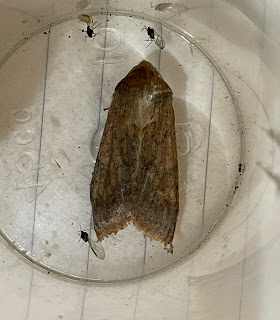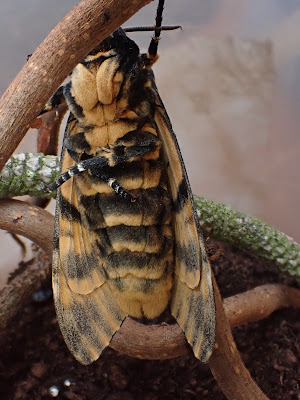Average nightly catches here during the last couple of weeks have been around 70 moths now that species such as Beaded Chestnut and Lunar Underwing are almost over, but with more than 20 species on most nights those are still excellent totals for the second half of October when there is normally nothing much flying in any great numbers apart from the November Moths. However, last night (30th) saw things drop significantly with only 22 moths of 14 species and I suspect the decline has now set in. The last of this month's additions to the garden year-list have now turned up, comprising Feathered Thorn (18th) and Sprawler (25th), while my first Mottled Umber of the season has now visited the trap (29th), which leaves just December Moth and Scarce Umber to put in an appearance sometime in the next week or two. In fact I've seen several December Moths already while trapping at different woodland sites over the past week, but none as yet in the garden.
 |
| Feathered Thorn, Westcott 18th October |
 |
| Sprawler, Westcott 25th October |
 |
| Mottled Umber, Westcott 29th October |
Other moths seen over the period have included late-season examples of
Metalampra italica (19th & 23rd), Oak Hook-tip (23rd), Single-dotted Wave (27th, a small and poorly marked specimen), Yellow-tail (22nd) & Straw Underwing (20th). The Straw Underwing, not the best marked of individuals, was my latest ever record and comes six weeks after what I thought would be my last sighting for the year on 7th September. It refused to show its hind-wings for the photo below but they were checked!
 |
| Straw Underwing, 20th October |
As Martin Townsend pointed out yesterday, these last two weeks have been exceptional for migrants. In fact the whole year has been excellent for them, even better than 2006 which is often quoted as one of the best in recent memory. The huge invasion of Crimson Speckled over the past week is unprecedented although needless to say they've managed to avoid me so far! In fact I've not had any of the really good species which have turned up this far inland during October but I've been very happy to get an almost continuous supply of the more common migrants in the garden:
(17th) Vestal (1).
(18th) Nomophila noctuella (2).
(19th) Nomophila noctuella (1).
(20th) - nil -
(21st) Nomophila noctuella (1).
(22nd) Nomophila noctuella (6), Vestal (1).
(23rd) Nomophila noctuella (2).
(24th) Vestal (1).
(25th) Udea ferrugalis (1), Nomophila noctuella (16), Vestal (1).
(26th) Nomophila noctuella (11), Vestal (1), Dark Sword-grass (1), Small Mottled Willow (1), Silver Y (1).
(27th) Nomophila noctuella (17), Scarce Bordered Straw (2).
(28th) Nomophila noctuella (10).
(29th) Plutella xylostella (1), Nomophila noctuella (15), Vestal (1), Small Mottled Willow (1).
(30th) Nomophila noctuella (3).
On top of the above there have been plenty of species such as Turnip, White-point, Angle Shades & Vine's Rustic which may or may not also have been migrants. It looks as though we're going to remain free of frost for some weeks yet so there's still a chance that some of the more interesting migrants that have already arrived in the country could turn up in the trap.
 |
| Small Mottled Willow, Westcott 26th October |
 |
| Scarce Bordered Straw, Westcott 27th October |
Dave Wilton Westcott, Bucks




.jpg)






.jpg)
.jpg)




.JPG)










.JPG)






















